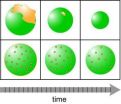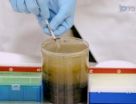(Press-News.org) TALLAHASSEE, Fla. Portions of Albert Einstein's brain have been found to be unlike those of most people and could be related to his extraordinary cognitive abilities, according to a new study led by Florida State University evolutionary anthropologist Dean Falk.
Falk, along with colleagues Frederick E. Lepore of the Robert Wood Johnson Medical School and Adrianne Noe, director of the National Museum of Health and Medicine, describe for the first time the entire cerebral cortex of Einstein's brain from an examination of 14 recently discovered photographs. The researchers compared Einstein's brain to 85 "normal" human brains and, in light of current functional imaging studies, interpreted its unusual features.
"Although the overall size and asymmetrical shape of Einstein's brain were normal, the prefrontal, somatosensory, primary motor, parietal, temporal and occipital cortices were extraordinary," said Falk, the Hale G. Smith Professor of Anthropology at Florida State. "These may have provided the neurological underpinnings for some of his visuospatial and mathematical abilities, for instance."
The study, "The Cerebral Cortex of Albert Einstein: A Description and Preliminary Analysis of Unpublished Photographs," will be published Nov. 16 in the journal Brain.
Upon Einstein's death in 1955, his brain was removed and photographed from multiple angles with the permission of his family. Furthermore, it was sectioned into 240 blocks from which histological slides were prepared. Unfortunately, a great majority of the photographs, blocks and slides were lost from public sight for more than 55 years. The 14 photographs used by the researchers now are held by the National Museum of Health and Medicine.
The paper also publishes the "roadmap" to Einstein's brain prepared in 1955 by Dr. Thomas Harvey to illustrate the locations within Einstein's previously whole brain of 240 dissected blocks of tissue, which provides a key to locating the origins within the brain of the newly emerged histological slides.
INFORMATION:
To view the study before the embargo lifts on Thursday, Nov. 15, at 7 p.m. Eastern time, visit http://www.oxfordjournals.org/our_journals/brainj/press_releases/prpaper.pdf. (If you have difficulty viewing this document, please copy and paste the URL into your browser.)
Uncommon features of Einstein's brain might explain his remarkable cognitive abilities
2012-11-16
ELSE PRESS RELEASES FROM THIS DATE:
Study shows large-scale genomic testing feasible, impacts therapy
2012-11-16
DENVER – Targeted cancer therapy has been transforming the care of patients with non-small-cell lung cancer (NSCLC). It is now standard practice for tumor specimens from NSCLC patients to be examined for EGFR mutations and ALK rearrangements to identify patients for therapy with EGFR and ALK inhibitors, respectively. Now, researchers say large-scale genomic testing is feasible within the clinical workflow, impacting therapeutic decisions. The study is published in the December 2012 issue of the International Association for the Study of Lung Cancer's (IASLC) Journal of ...
Study shows bone metastases treatment can improve overall survival
2012-11-16
DENVER – It is common for patients initially diagnosed with lung cancer to have the cancer spread to sites like the liver, brain and bone. One of the most frequent sites of metastases is the bone, with an estimated 30 to 40 percent of patients with non-small-cell lung cancer (NSCLC) developing bone loss. A study published in the December 2012 issue of the International Association for the Study of Lung Cancer's (IASLC) Journal of Thoracic Oncology, shows that the bone metastases drug denosumab was associated with improved overall survival compared with zoledonic acid (ZA). ...
LLNL scientists assist in building detector to search for elusive dark matter material
2012-11-16
Lawrence Livermore National Laboratory researchers are making key contributions to a physics experiment that will look for one of nature's most elusive particles, "dark matter," using a tank nearly a mile underground beneath the Black Hills of South Dakota.
The Large Underground Xenon (LUX) experiment located at the Sanford Underground Research Facility in Lead, S.D. is the most sensitive detector of its kind to look for dark matter. Thought to comprise more than 80 percent of the mass of the universe, scientists believe dark matter could hold the key to answering some ...
Study: Cellphone bans associated with fewer urban accidents
2012-11-16
CHAMPAIGN, Ill. — Cellphones and driving go together like knives and juggling. But when cellphone use is banned, are drivers any safer?
It depends on where you're driving, a study by University of Illinois researchers says.
The study found that, long-term, enacting a cellphone ban was associated with a relative decrease in the accident rate in urban areas. However, in very rural areas, cellphone bans were associated with higher accident rates than would otherwise be expected.
"The main idea is to use the eye test when it comes to cellphone use," says study leader ...
Airborne particles smuggle pollutants to far reaches of globe
2012-11-16
RICHLAND, Wash. -- Pollution from fossil fuel burning and forest fires reaches all the way to the Arctic, even though it should decay long before it travels that far. Now, lab research can explain how pollution makes its lofty journey: rather than ride on the surface of airborne particles, pollutants snuggle inside, protected from the elements on the way. The results will help scientists improve atmospheric air-quality and pollution transport models.
The results also show that the particles that envelop pollutants also benefit from this arrangement. The new study in Environmental ...
Simplifying heart surgery with stretchable electronics devices
2012-11-16
Researchers at the McCormick School of Engineering are part of a team that has used stretchable electronics to create a multipurpose medical catheter that can both monitor heart functions and perform corrections on heart tissue during surgery.
The device marks the first time stretchable electronics have been applied to a surgical process known as cardiac ablation, a milestone that could lead to simpler surgeries for arrhythmia and other heart conditions. The researchers had previously demonstrated the concept to apply stretchable electronics to heart surgery, but with ...
Medical vital-sign monitoring reduced to the size of a postage stamp
2012-11-16
CORVALLIS, Ore. – Electrical engineers at Oregon State University have developed new technology to monitor medical vital signs, with sophisticated sensors so small and cheap they could fit onto a bandage, be manufactured in high volumes and cost less than a quarter.
A patent is being processed for the monitoring system and it's now ready for clinical trials, researchers say. When commercialized, it could be used as a disposable electronic sensor, with many potential applications due to its powerful performance, small size, and low cost.
Heart monitoring is one obvious ...
Video-article shows how to purify magnetic bacteria
2012-11-16
Magnetotactic bacteria, like Magnetospirillum magneticum, have evolved cellular processes that allow them to take up iron molecules to produce magnetic nanocrystals like magnetite. Since they were first discovered and isolated in 1975 by Robert Blakemore, scientists continue to be fascinated by these unique bacteria, whether as a means to isolate biogenic magnetite or to understand the evolutionary advantages of producing these minerals. A new video-article in JoVE (Journal of Visualized Experiments) details a procedure to purify and enrich samples of magnetotactic bacteria ...
Researchers report potential new treatment to stop Alzheimer's disease
2012-11-16
Last March, researchers at UCLA reported the development of a molecular compound called CLR01 that prevented toxic proteins associated with Parkinson's disease from binding together and killing the brain's neurons.
Building on those findings, they have now turned their attention to Alzheimer's disease, which is thought to be caused by a similar toxic aggregation or clumping, but with different proteins, especially amyloid-beta and tau.
And what they've found is encouraging. Using the same compound, which they've dubbed a "molecular tweezer," in a living mouse model ...
WSU scientists find new way for antibiotic resistance to spread
2012-11-16
PULLMAN, Wash.—Washington State University researchers have found an unlikely recipe for antibiotic resistant bacteria: Mix cow dung and soil, and add urine infused with metabolized antibiotic. The urine will kill off normal E. coli in the dung-soil mixture. But antibiotic-resistant E. coli will survive in the soil to recolonize in a cow's gut through pasture, forage or bedding.
"I was surprised at how well this works, but it was not a surprise that it could be happening," says Doug Call, a molecular epidemiologist in WSU's Paul G. Allen School for Global Animal Health. ...


